Hello my name is John Moore. In February of 2004, I had a photovoltaic system installed on my house. Photovoltics is the proper name for solar panels. These panels take the light from the sun and convert it into electricity. This web page is an explaination of what it look like and how it works.
Let’s start with some pictures.
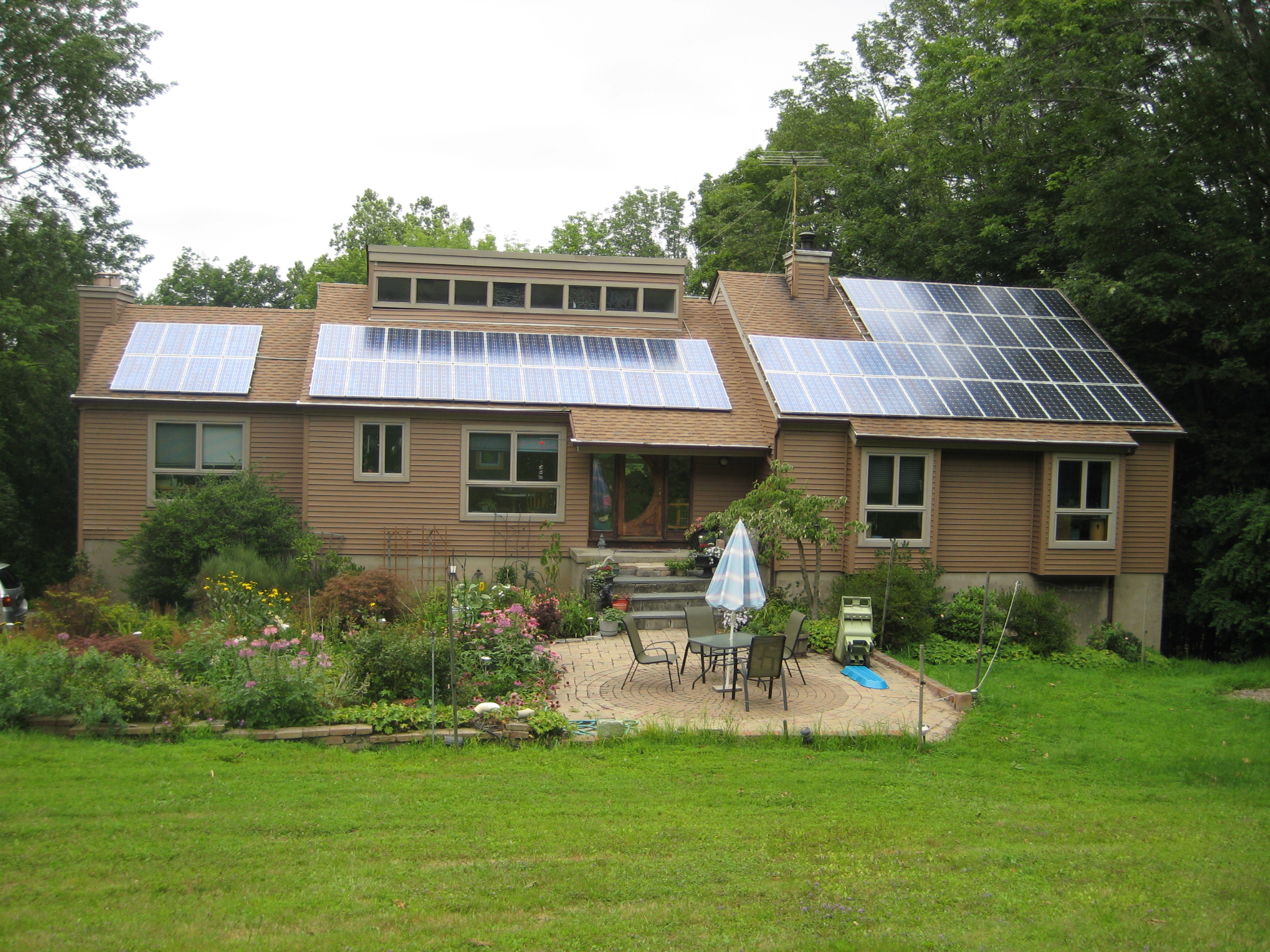
This is my home with the photovoltic panels on the roof. The system consists of 72 - 120 watt panels for a total of 8640 watts.
Now lets look at a part of the system located in my garage.

These are the inverters which convert the power from the solar panels into 240 volt AC so I can send the power back to Consolidated Editson, my electric provider.
How does it work?
When the sun shines on the planet it produces about 1000 watts of energy on each square meter of the earth at noon on a cloudless day. Yes the sun light that gives you a tan on the beach, or makes the blacktop hot under you feet is actually producting the equivalent of 10 - 100 watt light bulbs in every square meter of the planet. Now if you think in yards instead of meters, one square meter is equal to about 1.2 square yards. For a more detailed answer, I recommend you look at How Solar Energy Works.
So in a nut shell, the sun shines on the solar panels, and they convert the sun light into electricity. The output of the solar panels though is DC (Direct Current), like a battery. So you need a device called an inverter to convert the DC from the solar panels to AC (Alternating Current) like you get from your electric company. The inverters are the red boxes in the picture above.
Ok ready for the complicated part of the process? Well there isn’t one. No kidding. The solar panels convert sun light into DC electricity, and the inverters convert the DC into AC which goes into the circuit breakers in my house. The real fun is watching the electric meter run backwards.
Yes I left out the disconnect switches which turn off the power to work on the system, and the circuit breakers, two sets, which protect the other electric devices. But those are safety devices. There are only 2 active devices in the system under normal operation, the solar panels and the inverters.
How are the pieces connected?
OK now for those of you still curious about the hookup here is a drawing showing how all the pieces are connected.
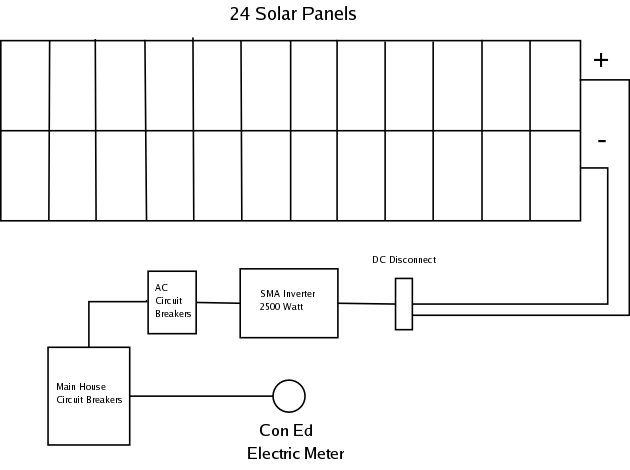
One thing you might notice is that there are 24 solar panels connected to one inverter. Since the solar panels are rated for 120 watts each, and the inverter is a 2500 watt unit, you combine many of them together to produce more power. Yes I know that 24 times 120 watts is 2880 watts, we will come back to that later.
The solar panels in the drawing are connected in series. Each panel has a Positive (+) wire and a Negative (-) wire. The positive of one panel connects to the negative of the one next to it. Confused, don’t be, if you have flash light that takes two batteries, they are connected in series. The top, or positive of one battery, presses against the negative of the other battery above it.
So a string of batteries works the same as a string of solar panels. The wires from the solar panels are connected to the input of the inverter. The inverters take in the DC power and convert it into AC electronically. Lets call it magic, since the explaination of what is happening inside the inverter is outside the scope of this presentation. The important part is that the power from the inverters looks, to the electric company, just like the power they sell you. This is good because the electricity from the power company can flow both into and out of your house.
If you would like more information about how Photovoltics work, I recommed having a look at Solar Energy Technologies program: for Consumers run by the US department of energy.
Running the Meter Backwards.
How can electricity flow from your house into the electric lines? Think of electricity as though it were water, and we will discuss how water flows. Electricity works in a similiar manner except it has electrons flowing instead of water.
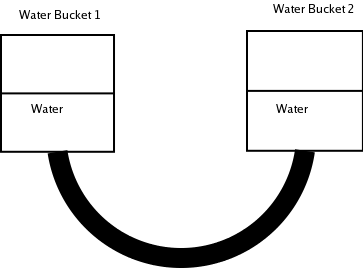
If you house were represented by water bucket 1 and your electric provider were water bucket 2. When you are not using any electricity, the water lever is the same in both buckets.
Now suppose you turn on a light in the house. You are using up energy to produce light. So your water level would go down, and more water would flow from the water bucket 2 through the hose into water bucket 1.
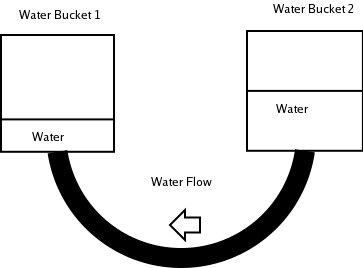
Since water likes to seek it own level, the water will move from one bucket to the other due to gravity. What is happening is that the light bulb is using up energy, in the form of electricity, so the amount of energy in the house is going down like the water. The electric company then sends energy to the house, like water moving through the hose.
So what happens when you have a sunny day and the inverters are producing electric energy? Your house is now producing more power than it is using so the flow is reversed.
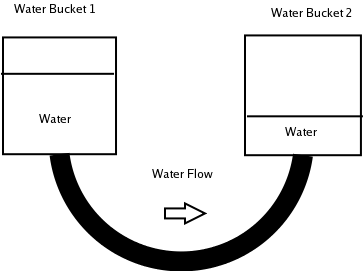
Since the amount of water in water bucket 1 is higher than in water bucket 2, the water flows through the pipe into bucket 2. If we were measuring the flow of water through the pipe it would be turning the meter the opposite direction from when we were running the light bulb above. What is happening is that the inverters are putting electricity back into the power lines to your house, so your electric meter is measuring the flow in reverse, from you to Con Ed.
The process of puting power back into the power lines is called Net Metering . You seem to be selling power to the electric company. But in effect you are really just replacing the energy you use from them with energy you collect from the sun. Thinks of it like a bank. When you are using electricity you consume it to do things in the house, like the electricity running the computer you are reading this on. When the Photovoltic system is running it is collecting energy from the sun, converting it into electricity, and putting it back into the power company’s wires. So your bill from the power company is only the difference between what you generated and what you used. This means that some months the power company might owe me money. But it is better to only settle the difference on a yearly basis. During the summer you might generate more power, but in the winter you might use more than you generate.
How did you decide to invest in a PhotoVoltic system?
The process of deciding on whether to install a PhotoVoltic system takes some time and research. The reason it takes some time is because you need to look at your costs and make some choices. Now instead of giving you a formula, I thought I would walk you through how I made the decision as an example of one way to decide. When appropriate I will give you a web link to useful literature on the subjects.
Step one - Get the Facts.
Since we are going to make a financial decision about investing in a Photovoltic system, it is good to gather the numbers first. Here is the list of my numbers and how I got them.
First a couple of information facts. My electric company is Consolidated Edison which supplies power to New York City and much of Westchester. My house is a contemporary with a single story and a roof area facing South-South-East of about 960 sqare feet. I made the decision in the spring of 2003 when we were considering taking out a consolidating morgage so we could do some other improvements to the house.
With the above fact in mind, lets start collecting information about my electrical usage and it’s cost. Con Ed has a servce where you can get a copy of your last 2 years worth of bills. So here is a portion of my bills which I will discuss below.
Table Costs before and after
| Begin Date | End Date | KwH used | Total | Cost per KwH | <=> | Begin Date | End Date | KwH used | Total Cost | Cost per KwH |
|---|---|---|---|---|---|---|---|---|---|---|
| 06/12/2003 | 07/14/2003 | 1,920 | $375.23 | 0.1954 | <=> | 06/12/2006 | 07/12/2006 | 945 | $179.57 | 0.1900 |
| 05/13/2003 | 06/12/2003 | 1,320 | $233.01 | 0.1765 | <=> | 05/11/2006 | 06/12/2006 | 173 | $42.45 | 0.2454 |
| 04/14/2003 | 05/13/2003 | 1,070 | $190.84 | 0.1784 | <=> | 04/13/2006 | 05/11/2006 | 130 | $39.43 | 0.2341 |
| 03/14/2003 | 04/14/2003 | 1,250 | $227.57 | 0.1821 | <=> | 03/15/2006 | 04/13/2006 | 62 | $20.48 | 0.3303 |
| 02/12/2003 | 03/14/2003 | 1,380 | $245.77 | 0.1781 | <=> | 02/13/2006 | 03/15/2006 | 285 | $55.91 | 0.1962 |
| 01/13/2003 | 02/12/2003 | 1,430 | $217.77 | 0.1523 | <=> | 01/12/2006 | 02/13/2006 | 604 | $110.46 | 0.1829 |
| - | - | Total | Total | Average | <=> | - | - | Total | Total | Average |
| - | - | 8,270 | $1,490.19 | 0.1802 | <=> | - | - | 2,199 | $439.30 | 0.1998 |
The table shows the billing period, the total number of KwH (Kilowatt Hours) used, the price I paid for the power delivered, and then my cost per KwH for the electricity. The first set of figures are for the 6 months before installing the solar panels. As a comparison I have included the same period in 2006 to show what the solar panels can do to your bills.
Let us take a minute to define what a KwH is. This is a measure of electrical energy over a period of time. Lets suppose you have an electric oven that uses 3000 watts of power to run. If you ran the oven for one hour you would have used 3000 watts per hour. If you convert watts to kilowatts, since kilo = 1000, you would have used 3 Kilowatts for one hour. Or 3 KwH. If you used the oven for 3 hours, you would have used 9 Kilowatt Hours or 9 KwH.
How big a system should I get?
After reading up on the incentive programs for New York State at Get Energy Smart , I realized that I did not want to generate more electricity than I would use in a year. Why? Well, when I buy electricity from Con Ed, I was paying an average of 18 cents per KwH. When I sell energy back to Con Ed, they only pay their costs, about 3 cents per KwH.
So given these facts, I decided to go for a system that should generate about 2/3 to 3/4 of my yearly load. So given the table above I decided to go for a system which should be able to produce about 10-12,000 KwH/year. I found information at Solar Thermal Energy which gave me the amount of solar radiation to use as an average, 4.5 hours of sunlight per day. So the math works out to 12000 / 365.25 / 4.5 = 7.3 Kilowatt of solar panels.
Now this would be an ideal system if it could produce as much as I calculated. So I decided to get bids for a system of 9 Kilowatts, about 25 bigger than I wanted to end up with. After reading the information at Power Naturally I started calling some of the installers recommended. After calling 6 different installers, and getting 4 proposals I select Mark Smith of Prime Energy based on the best price and system. I highly recommend shopping around, since the costs and proposals varied quite a lot. In order to compare the different proposals, I boiled them all down to a cost per watt for pricing comparison. I also looked at how close each system was to the size I wanted.
Now having a system that is good for the environment is great, but I also wanted to consider how long it would take me to pay back the system, also know a return on investment. The system I purchased will pay for itself in 11 years based on my calculations. What this means is that if I spent the amount of money I purchased the system for on electric bills how long would it take me to break even. So my goal was to save about $1800.00 per year. Since my bills before the system were averaging $233.00 per month, I was looking to bring them down to about $100.00 per month.
Recommendations
If you are still reading at this point you probably have an interest in what Solar Panels can do for you. I would recommend that you start by getting an energy audit. Start by logging into Make Your Home More Comfortable and Save Money and learn about how to get your home evaluated. Once you see what can be done to make your home better it is up to you. And if you are interested in solar panels, ask them to evaluate your home.
This document is a work in progress so it will change periodically.
Written by John F. Moore
Last Revised: Tue 01 Sep 2020 08:15:49 PM EDT

This work is licensed under a Creative Commons Attribution-NonCommercial-ShareAlike 3.0 Unported License.
